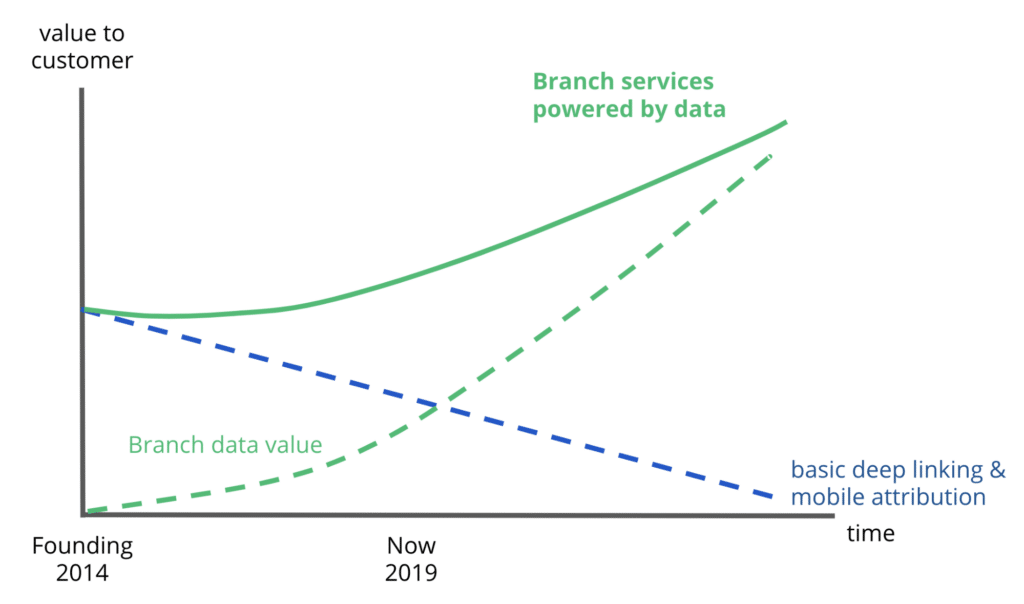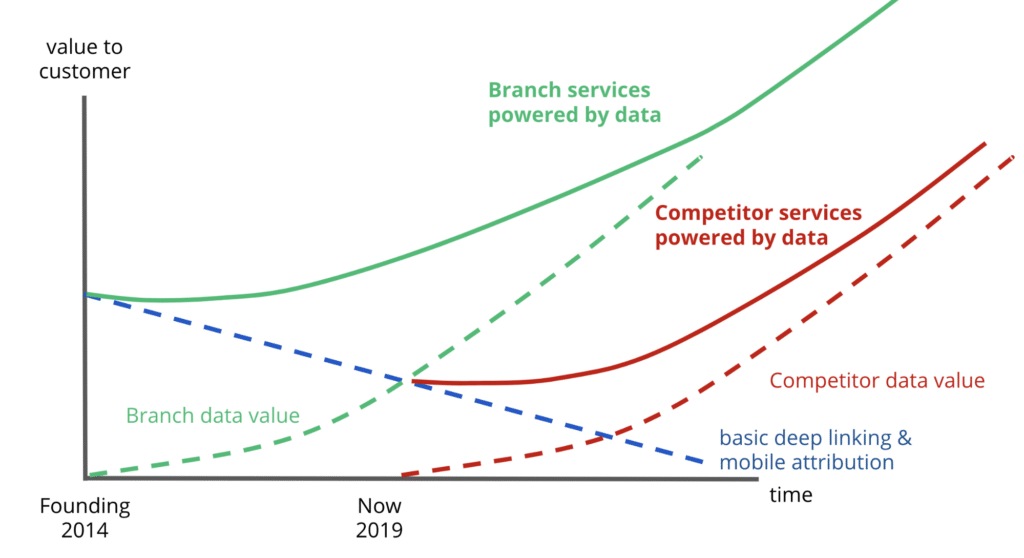“We chose Branch because they have the biggest data set to solve the cross-platform issue, which translates to greatly increased accuracy and reduced discrepancies. Comparing them to alternatives, we saw a 30% reduction in discrepancies from our own systems.”
–Mobile Engineering Lead at top ten app company in 2016.
When we started Branch back in 2014, we offered our entire deep linking and install attribution platform for free. Over the years, we have evolved our model and now provide access to Branch on a contractual basis and have companies paying us quite a lot of money! It wasn’t just that we started charging for our service. It’s that what we offer to customers has evolved dramatically over the years, and I wanted to take a minute to give our customers and the market an inside look into why we do what we do.
Back in 2014, the deep linking and app attribution market was in its infancy. There was no such thing as a Universal Link or an App Link, and core functionality was built with Javascript hacks for a bunch of different browsers to open installed-apps and basic IP address probabilistic modeling for deferred deep linking and install attribution. It took us a few months to build the system that would support the massive amount of traffic we would see.
Even before we started building this service, we knew the primary competition we’d face with a product like this would be commoditization and the decision to build vs. buy. That’s a challenge: If potential customers or competitors are able to build your software in a few months, or even a few years, there is an inherent limit to the size of your company and its potential impact on the world. If you look at companies that have created billions of dollars in value, they did not do it based on software features that could be replicable. They did it with a strategy focused on data. Key example: Google realized early on that the more search queries they could see, the better they could optimize results.
On day one at Branch, we realized that in order to create meaningful, lasting value and solve industry problems at scale, we would need to go beyond basic deep linking and mobile attribution. We would need to find a way to leverage our data to add value. We immediately identified multiple opportunities to greatly improve our deep linking success rate AND attribution accuracy, yet at the same time realized it would take years to collect enough data to make both products valuable. We proactively offered our basic deep linking and attribution services for free, knowing that over time these would be completely commoditized — but also knowing that we would ultimately be able to charge for the services built on top of Branch data.
Below is a chart showing the value of each component over time. The blue dotted line represents the value of basic deep linking and attribution services, and the green line represents the value of the Branch data pool. Branch products are the sum of both of these value curves, delivering the solid green line.

The problem we identified was that companies had no ability to connect user sessions across applications and platforms. A user might click a link in Facebook (which has its own browser), then click a link in Gmail (which has its own browser), then land on the company’s website via search. If the user then downloaded the app, there was no reliable way to identify whether or not all of these clicks and sessions were the same user.
The current technological solution to measure users from origin to destination is crude at best. Companies tend to use the IP addresses of a click event or a web session and model them to the IP address of an app session. If there’s a match, it is assumed it’s the same user.
The big issue: IP addresses are incredibly unreliable, and ~40% of the time, that matching assumption is incorrect because the user has changed IP addresses or shared wifi with multiple other users.
Branch decided to solve this problem with data. We started using Branch cookies across browsers, then deterministically mapping them to device IDs through deep linking.
We were uniquely able to do this because the core purpose of deep linking is to pass click data sourced from the web directly to the app where the device ID is accessible. As a result, our basic deep link services directly contributed to the data pool required to solve this challenge. If we had seen a user click a link and go into an app once, we never needed to use the IP address again for that user. You can read more about how this works here.
First, we ensured users had complete control of their data, then we started to deliver value to our customers with this data almost immediately.
We first introduced a concept called Match Guaranteed to our deep linking in 2015, which told companies that a match was made in real-time with 100% certainty. This opened up use cases like auto-login and other powerful features. Then, we introduced Intelligent Routing to our deep links in 2017, which allowed users to safely open an app when Branch data indicated that it was installed, without risking the appearance of an error message. The third major innovation was our disruptive Attribution Solution, which uses our cookie-device graph to give a unified, web + app view of marketing performance.
All of these products incentivize increased usage of deep links, which in turn continues to yield more valuable data. We refer to this as our Data Engine Strategy.

The strongest benefit of this strategy: It creates value for our customers in a way that no competitor can match. If data is the value proposition and gathering data takes time, then the company with the most data offers the most value, and therefore will continue to gain market share, allowing it access to more data, in a perpetual, self-reinforcing cycle.
That company is Branch. At this point, no other competitor is close. In fact, no competitor, even if they copied our technology, could approach Branch’s value proposition to its customers because they simply couldn’t amass a similar quantity of data. With each day that passes, Branch’s value proposition keeps increasing and our competitors remain in a perpetual game of catch-up.

Another reason I love this product strategy so much is the powerful network of support it creates. We started the Mobile Growth community within a few months of launching our product, because we recognized that a community of companies working together is much stronger than silos attempting to function independently. Similarly, when everyone joins the Branch platform, the shared connections of cookies-to-cookies and cookies-to-devices fixes key measurement and user experience problems.
In 2019 and beyond, we will continue to drive innovation based on our data platform, solving user identity challenges, as well as new fragmentation issues in mobile, desktop, connected TV, and more.
The future of mobile is bright, yet there is still so much more to be done. We look forward to winning, together.






















